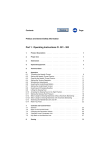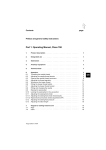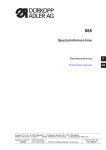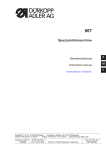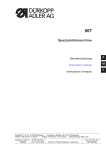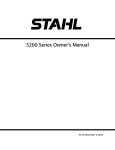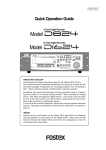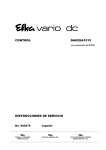Download Duerkopp Adler 841-27 Operating instructions
Transcript
Contents Page: Preface and General Safety Information Part 1: Operating Instructions Class 841-27 1. 1.1. 1.2 1.2.1 1.2.2 1.2.3 1.3 Product Description Proper Use . . . . . . . . . . . . . . . . . Short Description . . . . . . . . . . . . . Sewing Machine Head . . . . . . . . . . . Feed Unit . . . . . . . . . . . . . . . . . . New DÜRKOPP-ADLER-Controls (DAC) Optional Equipment . . . . . . . . . . . . 2. Technical Data 3. 3.1 3.2 Switching On/Off Switching On . . . . . . . . . . . . . . . . . . . . . . . . . . . . . . . . . . . . . . . . . . . . . . . . 8 Switching Off . . . . . . . . . . . . . . . . . . . . . . . . . . . . . . . . . . . . . . . . . . . . . . . . 8 4. 4.1 4.2 4.3 4.4 4.5 4.6 4.7 4.8 4.9 4.10 4.11 Operating the Sewing Machine Head Threading the Needle Thread . . . . . . . . . . . . . . . . . Winding the Underthread . . . . . . . . . . . . . . . . . . . . Inserting the Bobbin . . . . . . . . . . . . . . . . . . . . . . . Changing the Needle . . . . . . . . . . . . . . . . . . . . . . Regulating Sewing Arch Pressure . . . . . . . . . . . . . . . Setting the Buttonhole Length . . . . . . . . . . . . . . . . . Setting the Number of Stitches . . . . . . . . . . . . . . . . . Replacing and Setting the Knife . . . . . . . . . . . . . . . . Replacing and Setting the Knife (Cutting Block) . . . . . . . Replacing the Plastic Cutting Plate (only with Cutting Block) Needle Thread Tension . . . . . . . . . . . . . . . . . . . . . 5. 5.1 5.1.1 5.1.2 5.1.3 5.1.4 5.1.5 5.1.6 5.2 5.3 5.4 5.5 5.6 5.7 Feeding and Sewing Reference Position - Starting the Sewing Procedure - Voiding the Feed Reference Position . . . . . . . . . . . . . . . . . . . . . . . . . . . . . Selecting a Sewing Program . . . . . . . . . . . . . . . . . . . . . . . . Starting the Sewing Procedure . . . . . . . . . . . . . . . . . . . . . . . Voiding the Feed Procedure . . . . . . . . . . . . . . . . . . . . . . . . Continuing Sewing after Thread Breakage . . . . . . . . . . . . . . . . "No Material under Light Barrier" Display . . . . . . . . . . . . . . . . . Bobbin Change . . . . . . . . . . . . . . . . . . . . . . . . . . . . . . . Underthread Bobbin Empty . . . . . . . . . . . . . . . . . . . . . . . . . Re-sewing of Buttonholes . . . . . . . . . . . . . . . . . . . . . . . . . . Setting of the Clearance of the Buttonholes to the Positioning Edge . . Programming the Arrangement of the Buttonholes . . . . . . . . . . . . Removing Material . . . . . . . . . . . . . . . . . . . . . . . . . . . . . . . . . . . . . . . . . . . . . . . . . . . . . . . . . . . . . . . . . . . . . . . . . . . . . . . . . . . . . . . . . . . . . . . . . . . . . . . . . . . . . . . . . . . . . . . . . . . . . . . . . . . . . . . . . . . . . . . . . . . . . . . . . . . . . . . . . . . . . . . . . . . . . . . . . . . . . . . . . . . . . . . . . . . . . . . . . . . . . . . . . . . . . . . . . . . . . . 5 5 5 6 6 6 . . . . . . . . . . . . . . . . . . . . . . . . . . . . . . . . . . . . . . . . . . . . . . 7 1 . . . . . . . . . . . . . . . . . . . . . . . . . . . . . . . . . . . . . . . . . . . . . . . . . . . . . . . . . . . . . . . . . . . . . . . . . . . . . . . . . . . . . . . . . . . . . . . . . . . . . . . . . . . . . . . . . . . . . . . . . . . . . . . . . . . . . . . . . . . . . . . . . . . . . . . . . . . . . . . . . . . . . . . . . . . . . . . . . . . . . . . . . . . . . . . . . . . . . . . . . . . . . . . . . . . . . . . . . . . . . 9 . 10 . 10 . 12 . 12 . 13 . 14 . 15 . 17 . 18 . 19 Procedure . . . . . . . . . . . . . . . . . . . . . . . . . . . . . . . . . . . . . . . . . . . . . . . . . . . . . . . . . . . . . . . . . . . . . . . . . . . . . . . . . . . . . . . . . . . . . . . . . . . . . . . . . . . . . . . . . . . . . . . . . . . . . . . . . . . . . . . . . . . . . . . . . . . . . . . . . . . . . . . . . . . . . . . . . . . . . . . . 21 . 21 . 21 . 21 . 22 . 22 . 24 . 25 . 25 . 26 . 27 . 27 . 27 3 Contents 6. 6.1 6.2 4 Page: Maintenance Cleaning and Inspection . . . . . . . . . . . . . . . . . . . . . . . . . . . . . . . . . . . . . . . . . 28 Lubrication . . . . . . . . . . . . . . . . . . . . . . . . . . . . . . . . . . . . . . . . . . . . . . . . 29 1. Product Description 1.1 Proper Use The DÜRKOPP ADLER 841-27 is a sewing unit which can properly be used for the sewing of light to medium weight material. Such material is, as a rule, material made up of textile or synthetic fibers. These materials are used in the garment industry. Generally, only dry material may be worked with this sewing unit. The material may not be thicker than 4 mm when pressed together by the lowered presser foot. The material may not contain any hard objects because the machine could otherwise only be operated with eye protection. Such eye protection is not available at this time. The seam is generally sewn with sewing yarns of a dimension up to 65/2 Nm (synthetic threads with cotton covering or synthetic threads). Those wanting to use other threads must first estimate the dangers arising the refrom and, if necessary, take appropriate safety measures. This sewing unit may only be installed and operated in dry and clean premises. If the sewing unit is used on other premises which are not dry and clean, further measures, which are to be agreed upon, may be necessary (see EN 60204-31:1999). We, as a manufacturer of industrial sewing machines, assume that at least semi-skilled operating personnel will be working on our products so that all normal operations and, where applicable, their dangers are presumed to be known. 1.2 1 Short Description The 841-27 is a sewing unit for the automatic sewing of buttonholes in shirt and blouse fronts. Because of the construction of the sewing unit in independent function modules, such as feed, advancing, sewing station and stacker, a completely overlapping work procedure is possible. In the feed unit the fronts (material) are positioned along a stop and at markers and fixed by a vacuum. After the transfer of the material into the advancing unit the transport occurs in pre-programmed steps (buttonhole spacing) to the sewing station. During the sewing of the buttonholes the advancing unit moves synchronously to the transport movement of the sewing machine. Then a return to the initial position and the material is stacked. 1.2.1 Sewing Machine Head – – – – – – – – Double saddle stitch - automatic buttonhole machine with bottom and top feed. Normal manner of sewing, right side of material (side seen) up during sewing. Pneumatically-operated cutting system with slot in the needle plate. When the needle thread breaks, the needle thread monitor interrupts the sewing cycle, the cutting is prevented. Then it is possible to conduct a repair seam as well as removal of the material. The underthread quantity is controlled by an underthread counter. Sewing drive via DC motor. Material transport via step motor. Mechanical quick change for the clearance of the buttonholes to the front edge of the material. 5 1.2.2 Feed Unit The feed unit is prepared for connection to an in-house vacuum unit. A vacuum distributor with filter is available as optional equipment. It allows for the attachment of up to 3 sewing units to an in-house vacuum unit. If no in-house vacuum unit exists the rotary blower, which is available as optional equipment, must be ordered. The vacuum performance is sufficient for 3 sewing units. 1.2.3 New DÜRKOPP-ADLER-Controls (DAC) The graphical operator guidance occurs exclusively via internationally understandable symbols. The various symbols are combined into groups within the menu structure of the sewing and testing programs. The simple operation makes possible short training times. The user has 99 freely-programmable sewing programs and four sequences which can be called up at his disposal. Each sequence can be combined in any desired order out of a maximum of 3 buttonhole programs. All programmed buttonholes and sequences can be saved on a RAM memory card. The comprehensive MULTITEST testing and error diagnostic system is integrated in the DAC. A microcomputer assumes the control tasks, monitors the sewing process and shows operator errors and malfunctions in the display of the control panel. 1.3 Optional Equipment A flexible system of optional equipment allows the sewing unit to be optimally and economically fitted out for each individual application. Equipment 6 Material number Vacuum distributor 0841 597514 Rotary blower 3 x 380-415 V; 50 Hz 9800 810001 1 Rotary blower 3 x 220-240 V; 50 Hz 9800 810001 2 Rotary blower 3 x 220-240 V; 60 Hz 9800 810001 3 Pneumatic connections kit 0797 003031 Halogen sewing light with support 9822 510000 Retrofit kit-block cutting, max. buttonhole length 22 mm for 0841 E00114 22 0577 590014 Retrofit kit-block cutting, max. buttonhole length 35 mm for 0841 E00114 35 0577 590024 2. Technical Data Machine head: Class 577-1111 Needle system: System 265 (slight ball point) Needle thickness: [Nm] 70 to 100, Standard 80 Yarns: [Nm] synthetic threads and synthetic threads with cotton covering up to 65/2 Sewing stitch type: Number of stitches: - at delivery Delivery with 841-E114/22 Number of stitches per seam construct: - at delivery Buttonhole length: Buttonhole width: Incision length: - at delivery Delivery with 841-E114/35 Number of stitches per seam construct: - at delivery Buttonhole length: Buttonhole width: Incision length: - at delivery 301/Double saddle stitch -1 [min ] [mm] [mm] [mm] [mm] [mm] [mm] 1000 to 4000 3500 91, 120 149 120 max. 22 4 6, 8, 10, 12, 14, 16 12 127, 149, 173, 223, 261 173 max. 35 4 18, 20, 22, 24, 26, 28 20 Max. length of the material [mm] 900 Minimum width of the material [mm] 250 Distance between the first and last buttonhole [mm] 650 Clearance between individual buttonholes [mm] 40 Clearance of the buttonhole to the front edge [mm] 10-22 Sewing motor: 1 EFKA DC1600/DA82GL Nominal rating: [kW] 0,75 Working overpressure: [bar] 6 Air consumption: [NL] approx. 15 per work cycle Rated voltage: 1~ 190 - 240 V, 50/60 Hz Electr. connected load [kVA] 1,5 Dimensions: [mm] 2100 x 940 x 1560 Work height: [mm] 930 Weight (without optional equipment): [kg] 290 Specified noise level: Lc dB (A) 7 3. Switching On/Off 1 2 3 4 3.1 Switching On For the operational readiness of the sewing unit the feed rail must be run into the reference position once after switching on. The reference position is required in order for the controls to receive a defined base position for the feed rail. Caution Risk of Injury ! Do not reach into the motion area of the feed rail 3 during the reference run. – – – – – – Turn on the switch 1 of the head of the sewing machine. Turn on the main switch 2. The controls load the machine program. The DÜRKOPP-ADLER logo appears briefly in the display of the control panel. The operator is prompted to start the reference run by the "<==== REF" message. Operate the start switch 5. The feed rail runs into its left end position. The screen changes to the main display. The sewing unit is ready for operation. For switching the rotary blower (optional equipment) on: turn the switch of the rotary blower to the "I" position. 5 3.2 Switching Off – – – – 8 Turn off the main switch 2. Turn off the switch 1 of the head of the sewing machine. The sewing unit is disconnected from the power supply. It is no longer ready for operation. For switching the rotary blower (optional equipment) off: turn the switch to the 0 position. 4. Operating the Sewing Machine Head 4.1 Threading the Needle Thread Caution Risk of Injury ! Turn off the main switch 1 of the sewing machine head ! Thread the needle thread only with the machine head turned off. – Thread the needle thread as shown in the illustration. 1 9 4.2 Winding the Underthread 3 1 2 – – – – – – – – 4.3 Place the yarn spool on the yarn stand. Thread the underthread as shown in the illustration. Place the bobbin on winder 1. Wind the underthread clockwise approx. 5 times around the bobbin core. Swing winder lever 2 to the bobbin and let catch. The bobbin is filled during sewing. The bobbin can also be filled outside the sewing sequence (see Chapter Bobbin Change) Winder lever 2 ends the winding procedure as soon as the bobbin is filled. After the winding, tear off the underthread at thread clamp 3. Inserting the Bobbin Caution Risk of Injury ! Turn off switch 1 for the sewing machine head! The bobbin can only be changed with the machine head turned off! Removing the empty bobbin. – Flip bracket 5 up and remove the bobbin case top with bobbin. – Remove the empty bobbin from the bobbin case top. 10 5 Threading the bobbin – Insert a full bobbin into the bobbin case top, the bobbin must thereby turn counterclockwise when the underthread is pulled off. – Guide the underthread through slot 6 under spring 7. – Depending on the desired buttonhole, the underthread must be guided through slot 9 for a raised-form buttonhole (more thread is pulled forward over the hook back) or through slot 10 for a flat-form buttonhole (less thread). – Cut off the thusly threaded underthread at knife 11. Setting the underthread tension – Set the underthread tension by turning screw 12 so that the bobbin case slowly lowers under its own weight with the thread end held tight. 11 6 9 10 12 7 Inserting the bobbin case top – Place the bobbin case top with bobbin on the bobbin case bottom taking care that bracket 5 can be heard to catch. 11 1 4.4 Changing the Needle 1 2 Caution Risk of Injury ! Turn off the switch 1 of the sewing machine head. Change the needle only with the sewing machine head turned off. – – – 3 – – Loosen screw 1. Remove the needle from the needle bar. Push the new needle into the drilled hole of the needle bar up to the stop. Align the needle so that the furrow 3 lies on the side not facing the knife. Tighten screw 1. ATTENTION ! The factory-set clearance of the hook to the needle is set for needles with a thickness of 80. After the change to a different needle thickness the clearance must be corrected (see Service Instructions). 4.5 Regulating Sewing Arch Pressure The sewing arch pressure should be set to the maximum value. The sewing arch pressure must only be lowered in case of delicate fabrics. – The sewing arch pressure can be regulated at screw 2. 12 4.6 Setting the Buttonhole Length Caution Risk of Injury ! Turn off the switch of the sewing machine head. Change the buttonhole length only with the sewing machine head turned off! 2 1 1 – – – – – – – – – – – – Turn off the switch for the machine head. Pull off the hand crank 1. Lift lid 2 up to the stop. Loosen screw 3. Adjust lever 4 in the link so that the set buttonhole length results. Tighten screw 3. Unlock support 5 and close lid 2. Attach hand crank 1. Turn on the switch for the machine head. Set the new buttonhole length with the "Buttonhole Length" function in the "Buttonhole Parameters" menu. Call up the "One-time Sewing" menu (1X) and sew a buttonhole. Check if the set buttonhole length corresponds with the sewn buttonhole. 5 3 4 13 4.7 Setting the Number of Stitches 2 5 6 Caution Risk of Injury ! Turn off the main switch! Change the number of stitches only with the machine turned off! – – – – – – – Pull off the hand crank . Lift lid 2 up to the stop. Exchange the alternative wheels 6 pair-wise according to the table. Unlock support 5 and close lid 2. Attach hand crank. Turn on the sewing unit. Set the number of stitches to the same value in the "Buttonhole Parameters" menu with the "Number of Stitches" function. 841 with sewing device 841-E114/22 Number of stitches Number of teeth upper / lower 91 120 149 25 / 54 30 / 49 34 / 45 841 with sewing device 841-E114/35 Number of stitches Number of teeth upper / lower 127 149 173 223 261 14 31 34 37 42 45 / / / / / 48 45 42 37 34 4.8 Replacing and Setting the Knife Caution Risk of Injury ! Turn off the main switch! The sewing arch must be in the base position otherwise the knife strikes on the sewing arch! 1 3 1 2 Removing the knife – Loosen nut 1. – Pull out knife 2. Attaching the knife – Insert a new knife (nut 1 loosened) and first push all the way up. ATTENTION ! It is essential to take care that there is a clearance of 1 mm min. between the needle thread shears and the lower edge of the knife. Caution Risk of Injury ! When operating the keys on the controls do not reach into the area of the knife for any reason. – – – – – Tighten the nut. Turn on the switch for the machine head. Turn on the main switch. Press the F2 key when the Dürkopp Adler logo displays. The menu for the machine-specific setting and test programs appears. Select the "Machine Head" function. 15 ATTENTION ! During the use of the setting program do not turn on the handwheel or the hand crank! – – If necessary, lower the sewing arch by pressing the F3 key. With the setting aid still turned on, the knife block can now be moved downward with the F4 key. – By pressing the F4 key again the knife block can be run up again. If the sewing arch is not lowered the knife block can not be run downward with the F4 key. First the sewing arch must then be lowered with the F3 key. Also the function of the F3 key (lift sewing arch) is blocked with the knife lowered. Aligning the knife The front edge of the knife should lay approx. 2 mm under the upper edge of the needle plate with the knife block lowered. Setting: – Lift the sewing arch. – Slightly loosen nut 1. – Move the knife. – Tighten nut 1. – Check the incision depth, if necessary repeat the procedure. The incision of the knife should lie about 2 fabric threads in front of the last sewn back tack. Setting: – Loosen screw 3 and set the clearance accordingly. Observe: With the knife block lowered there must be a safety clearance of 0.5 mm between the front edge of the knife and the slot in the needle plate insert. – Tighten screw 3. Ending the setting aid – Press the "F1" key. The setting program is ended. 16 4.9 Replacing and Setting the Knife (Cutting Block) Caution Risk of Injury ! Turn off the main switch! The sewing arch must be in the base position otherwise the knife strikes on the sewing arch! 3 1 2 1 4 5 4 Removing the knife – Loosen nut 1. – Pull out knife 2. Attaching the knife – Screw in completely the knife depth stop – Insert a new knife (nut 1 loosened) and first push all the way up. ATTENTION ! It is essential to take care that there is a clearance of 1 mm min. between the needle thread shears and the lower edge of the knife. Caution Risk of Injury ! When operating the keys on the controls do not reach into the area of the knife for any reason. – – – – – Tighten the nut. Turn on the switch for the machine head. Turn on the main switch. Press the F2 key when the Dürkopp Adler logo displays. The menu for the machine-specific setting and test programs appears. Select the "Machine Head" function. 17 ATTENTION ! During the use of the setting program do not turn on the handwheel or the hand crank! – – – If necessary, lower the sewing arch by pressing the F3 key. With the setting aid still turned on the knife block can now be moved downward with the F4 key. By pressing the F4 key again the knife block can be run up again. If the sewing arch is not lowered the knife block can not be run downward with the F4 key. First the sewing arch must then be lowered with the F3 key. Also the function of the F3 key (lift sewing arch) is blocked with the knife lowered. Setting the knife to cut With the knife block lowered and the knife depth stop screwed completely in, the knife should lay onto the plastic cutting block. Setting: – Lower the knife block. – Slightly loosen nut 1. – Press the knife onto the cutting block. – Tighten nut 1. – Conduct a sewing trial and check the cut, if necessary correct the cutting depth with the knife stop. The incision of the knife should lie about 2 fabric threads in front of the last sewn back tack. Setting: – Loosen screw 3 and set the clearance accordingly. Observe: With the knife block lowered there must be a safety clearance of 0.5 mm between the front edge of the knife and the slot in the needle plate insert. – Tighten screw 3. Ending the setting aid – Press the "F1" key. The setting program is ended. 4.10 Replacing the Plastic Cutting Plate (only with Cutting Block) – – – – 18 Loosen screws 4. Pry out cutting plate 5 with a screwdriver and remove it. Insert a new cutting plate, press on the holder and tighten the screws 4. Conduct the setting as per the Chapter " Replacing and Setting the Knife (Cutting Block)". 4.11 Needle Thread Tension At the factory the machine head is set so that buttonholes with flat-form tacking and raised-form buttonhole seams are sewn. 4 5 6 1 Pre-tension The pre-tension 4 is always in effect. It serves to quiet the needle thread. The setting value should be very small (5-10 g). The pre-tension 4 has little influence on the seam construct. Main tension The main tension 5 is effective when sewing the two buttonhole seams of the buttonhole. The main tension 5 is open during sewing of the tacking as well as during thread trimming. Tacking tension The tacking tension 6 opens only during thread trimming, otherwise this tension is closed during the complete sewing procedure. Buttonhole seam tension The buttonhole seam tension is mutually generated by the main tension 5 and tacking tension 6, whereby about 1/3 of the buttonhole seam tension should be generated by the tacking tension 6. Setting – Thread the needle thread so that it does not run through the main tension 5. – Call up the "One-time Sewing (1X)" menu and sew a buttonhole. 19 – Set the tacking tension 6 so that, during the sewing procedure, the greatest possible quantity of needle thread from the yarn spool is used without the needle thread above the pre-tension fluttering too much or tearing. – Thread the needle thread as per Chapter 4.1 (needle thread through the main tension). – Call up the "One-time Sewing (1X)" menu and sew a buttonhole. – Set the main tension 5 so that, during sewing of the buttonhole seams, a satisfactory seam construct is achieved (uniform raised-form buttonhole seams). If the seam quality worsens after a change of thread, a correction should occur only by turning the main tension 5. Checking – Thread needle thread and underthread of different colors. – Conduct a trial seam. With two-color sewing the color of the needle thread should only be visible in the tacking of the buttonhole from above. 20 5. Feeding and Sewing 5.1 Reference Position - Starting the Sewing Procedure - Voiding the Feed Procedure 5.1.1 Reference Position For the operational readiness of the sewing unit the advancing unit must be run into the reference position once after switching on. The reference position is required in order for the controls to receive a defined base position for the advancing unit. Caution Risk of Injury ! Do not reach into the motion area of the feed and advancing units during the reference run. – – – – Turn on the main switch. The controls load the machine program. The DÜRKOPP-ADLER logo appears briefly in the display of the control panel. The operator is prompted to start the reference run by the display of the "<==== REF" message. Operate the start switch. The advancing unit runs into its left end position. The screen changes to the main display. The sewing unit is ready for operation. 5.1.2 Selecting a Sewing Program When the main screen displays, the program sequence can be changed using the × and Ø keys. The buttonhole program within the buttonhole sequence can be changed with the Õ and Ö keys (see also Part 4: Programming Instructions "Main Display"). If a buttonhole sequence is to be changed or newly generated: – With the main display showing, press the F3 key. The buttonhole sequence submenu appears. The buttonhole sequences can be generated and changed here. (see also Part 4: Programming Instructions "Buttonhole Sequence"). 5.1.3 Starting the Sewing Procedure Caution Risk of Injury ! When triggering the sewing procedure do not reach into the motion area of the feed and advancing units. Dependent on the setting of the "Knee Switch" parameter in the Global Parameters menu, the sewing procedure is started in the following manner: Starting the sewing process only through pressing the start key – Press the knee switch. The vacuum is turned on. – Press the start key. The sewing procedure starts. Starting the sewing process with a delay, using the knee switch – Press the knee switch. The vacuum is turned on. The sewing procedure starts automatically after the defined period. The sewing process starts after releasing the knee switch – – Strike the knee switch. The vacuum is turned on. Release the knee switch. The sewing procedure starts. 21 1 5.1.4 Voiding the Feed Procedure The feed procedure can be voided for making corrections: – Strike numeric key "3" on the control panel. or if the "Knee Switch" function is turned on, press the knee switch again. – The vacuum field is turned off. 5.1.5 Continuing Sewing after Thread Breakage 1 2 When the thread monitor registers a breakage of the needle thread, the following procedures are triggered : – The current buttonhole is completed without thread. – The thread breakage symbol appears in the display. The sewing procedure is interrupted. – Select one of the symbols for continuing, which are described under the points 1, 2 and 3, with the arrow keys "×" and "Ø". 1. Cover-seaming 2. New feed 3. Continuing sewing Caution Risk of Injury ! Thread the needle thread only with the sewing machine head turned off. 1. Cover-seaming – Strike the enter key or start key. – Turn off switch 1 for the sewing machine head. The symbol for "Secured Stop" appears. – Rethread the needle thread. – Turn on the switch for the sewing machine head. The indicator at the left appears. – Strike the enter key. The sewing procedure continues. 22 2. New feed – Select the symbol at the left with the arrow keys "×" and "Ø". – Strike the enter key. The advancing device swings to the back. The indicator at the left appears. – Strike the enter key or start key. The clamping rail opens. – Remove the material. – Turn off the switch for the sewing machine head. – Rethread the needle thread. – Turn on the switch for the sewing machine head. – Select the the buttonhole at which the sewing procedure should continue with the arrow keys "Õ" and "Ö". – Strike the enter key. The main menu appears in the display. The thread breakage symbol appears at the bottom right in order to indicate that the sewing unit is in the thread breakage mode. – To void the thread breakage mode strike key "3". – To continue sewing, feed the material again and strike the start key. The sewing procedure is continued at the desired position. 1 3. Continuing sewing – Select the symbol at the left with the arrow keys "×" and "Ø". – Strike the enter key. The advancing device runs to the right and the clamping rail swings. – Turn off the switch for the sewing machine head. – Rethread the needle thread. – Turn on the switch for the sewing machine head. – Select the buttonhole at which the sewing procedure should continue with the arrow keys "Õ" and "Ö". – – Strike the enter key. A symbol appears on the side. Eventually adjust the material position. Strike the enter key. The sewing process will continue from the wished position. 23 5.1.6 "No Material under Light Barrier" Display 1 2 3 The light barrier 1 checks if material is present. If no material lies under the light barrier, the indicator at the left appears in the display. The indicator can appear under following conditions: – The material was displaced. – The material has run out. – The light barrier is incorrectly set. – There is no material under the light barrier. – The sewing procedure was started unintentionally. Removing the material – Strike the enter key. The advancing device runs into the base position. – Strike the enter key again. The clamping rail opens. – Remove the material. Realigning the material – When the material is realigned so that the light beam is interrupted, the display changes so that the symbol at the left appears. – Strike the enter key. The sewing procedure is continued. Light barrier If there is still material lying under the light barrier, the sensitivity of the light barrier must be altered. – Turn adjusting screw 3 clockwise until the LED 2 goes out. "ESC" key function Dependent on the display, a different function is triggered with the "ESC" key than with the enter key. – The advancing device runs into the base position. Strike the enter key. The material can be removed. – The next buttonhole is sewn. 24 5.2 Bobbin Change The specified value (number of button holes) is shown with the numeric key "2". – The symbol at the left appears in the display. Now a new value can be specified with the numeric keypad. – In order to reset the counter for the number of underthread stitches to the specified or the set value, strike the enter key. – To exit leaving the display unchanged, strike the "ESC" key. Winding the underthread – Select the symbol at the left with the arrow keys "×" and "Ø". – When this symbol is selected the screen at the left appears. – The sewing drive is started with the "F2" key. – The sewing drive is stopped with the "F3" key. – One returns to the main menu with the "F1" key. 1 5.3 Underthread Bobbin Empty When the underthread counter has counted down to 0, the following procedures are triggered: – When the underthread counter has counted down to 0 during the sewing of the buttonhole facing, the advancing unit runs into the right end position. – The "Underthread Bobbin Empty" symbol appears in the display. The sewing procedure is interrupted. – Turn off switch 1 for the sewing machine head. The "Secured Stop" symbol appears. – When the underthread bobbin is empty after the sewing of the last buttonhole on the buttonhole facing, the material is stacked. Caution Risk of Injury ! Change the bobbin only with the sewing machine head turned off. – – – – Change the bobbin. Turn on the switch for the sewing machine head. The indicator at the left appears. The set underthread capacity is shown. If the underthread capacity is to be changed, enter the new value with the numeric keypad and confirm with the enter key. If the value for the underthread capacity is not to be changed, strike the enter key. The sewing procedure is continued. 25 5.4 Re-sewing of Buttonholes Individual buttonholes of a buttonhole facing can be re-sewn with the "Re-sewing of Buttonholes" function. The re-sewing mode can also be turned on during the sewing procedure. – Strike key "5" in the main menu. The symbol is shown as a negative. The re-sewing of individual buttonholes is turned on. – To turn off the re-sewing of buttonholes strike key "5" in the main menu. The symbol is shown normally. The re-sewing mode is turned off. – After the next stacking procedure the re-sewing mode is turned off automatically. Sewing procedure with turned-on re-sewing mode – Insert material. – Strike the start key. The sewing procedure is triggered. The advancing device transports the material up to the first buttonhole position. – A selection window with the following 4 options appears in the display : 1. 2. 3. 4. 1. Sewing – Select the symbol at the left with the arrow keys "×" and "Ø". – Strike the enter key. The buttonhole in the current position is sewn. 2. Move on – Select the symbol at the left with the arrow keys "×" and "Ø". – Select the buttonhole up to which the advancing device should transport the material with the arrow keys "Õ" and "Ö". – Strike the enter key. The material is transported to the entered buttonhole position. 3. Complete sewing of the material – Select the symbol at the left with the arrow keys "×" and "Ø". – Strike the enter key. All buttonholes as of the current position are re-sewn. After the sewing procedure the material is stacked. 4. Stacking – Select the symbol at the left with the arrow keys "×" and "Ø". – The following functions can be selected with the arrow keys "Õ" and "Ö": Remove material Stack material – 26 Strike the enter key. 5.5 Setting of the Clearance of the Buttonholes to the Positioning Edge 1 2 1 The clearance of the buttonholes to the positioning edge can be set with the setting wheel 1. The indicator 2 serves as orientation to quickly see how the clearance is set. The clearance of the buttonholes to the positioning edge can lie in a range from 10 to 22 mm. 5.6 Programming the Arrangement of the Buttonholes The buttonhole arrangement can, with the 841-27, be changed via the controls. The following parameters can, among others, be altered : – Material - men’s shirt or women’s blouse – Regular or irregular arrangement of the buttonholes – Spacing of the buttonholes – Sewing begin How the settings are made is described in Part 4:Programming Instructions in the Chapter "Buttonhole Program". 5.7 Removing Material – – – Strike key "4" in the main menu. The symbol is shown as a negative. The stacker is opened. Remove material. After the next sewing procedure the stacker is automatically closed again. 27 6. Maintenance Caution Risk of Injury ! Turn off the main switch. The maintenance of the sewing unit may only be conducted when the machine is turned off. The maintenance work must occur at the latest as per the maintenance intervals listed in the tables (see column Operating Hours). 6.1 Cleaning and Inspection 1 2 3 Maintenance work to be conducted Remarks Machine head Remove sewing dust, thread rests and cutting residue. Particularly to be cleaned: - Underside of the needle plate, top of the needle plate (slider) - Sewing arch - Area around the hook - Bobbin case - Thread trimmer - Light barrier Hours of Operation 8 Sewing drive Check condition of the V-belt. 160 Pneumatic system Check and/or set air pressure. 8 Check water level in the pressure regulator. The water level should not rise up to the filter insert 1. After screwing in the drain screw 3, drain the water out of the water separator 2 under pressure. Clean the filter insert. 40 500 Dirt and condensation are removed through the filter insert 1. Separate the machine from the compressed air supply. Screw in the drain screw 3. The pneumatic system of the machine must be pressure-free. Screw off the water separator 2. Screw off the filter insert 1 and wash out the dirty filter bowl and filter insert with naphtha (no solvents!) and blow dry. Reassemble the maintenance unit and attach. Check the system for leaks. 500 Running carriage Renew lubrication Switch cabinet Clean the filter mat of the switch cabinet ventilator 28 500 8 6.2 Lubrication Caution Risk of Injury ! Oil can cause skin rashes. Avoid longer skin contact. After contact wash yourself thoroughly. ATTENTION ! The handling and disposal of mineral oils is subject to legal constraints. Deliver used oil to an authorized reception point ! Protect your environment.Take care not to spill any oil. For lubrication use only ESSO SP-NK 10 lubricating oil or an equivalent oil with following specification: – Viscosity at 40°C: 10 mm 2 /s – Flash point: 150°C The oil is available from DÜRKOPP ADLER AG sales offices under the following parts no.s: – 2 liter container: 9047 000013 – 5 liter container: 9047 000014 2 1 Maintenance work to be conducted Remarks Hook lubrication Check the oil level in reservoir 1. Tilt the machine head to the back. Fill reservoir 1 through the filler opening up to the "max" mark with oil. 8 Machine head lubrication Check the oil level in reservoir 2. The oil level should not drop below the "min" mark. If necessary, fill oil through the drilled hole in the viewing window up to the "max" mark. 40 Hours of Operation 29 1




























